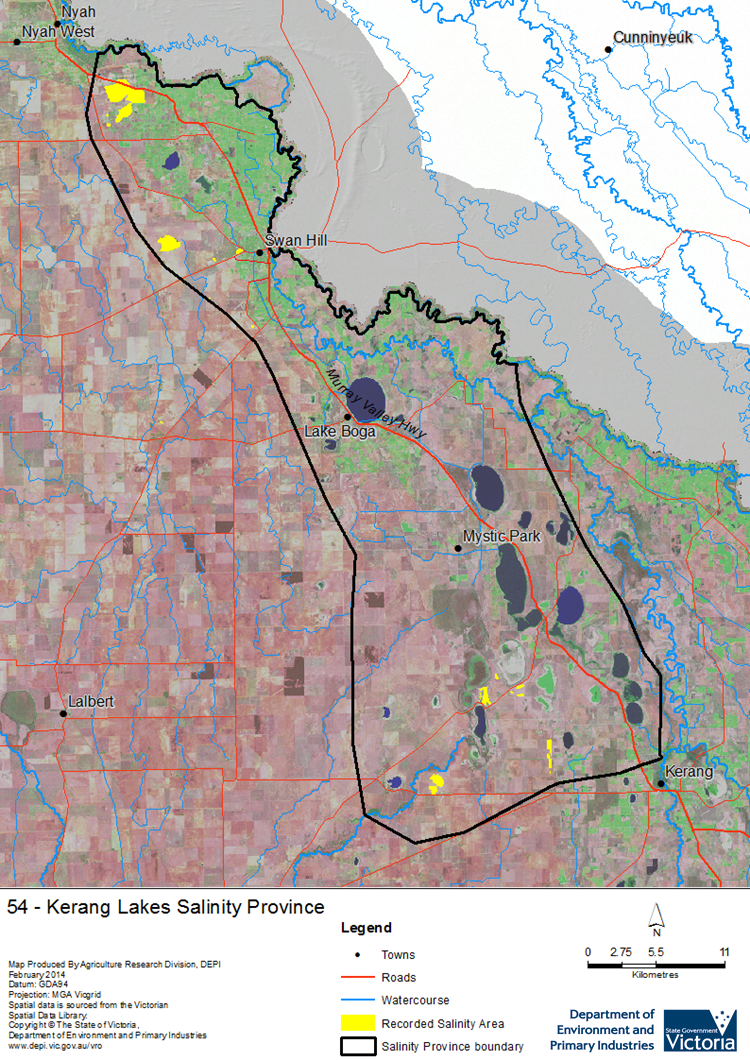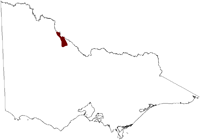Salinity Province 54, Kerang Lakes
|
|
Province Attributes
| Catchment Management Region: | NORTH CENTRAL |
| Priority Status: | High |
| Province Area: | 108,370 ha |
| Recorded Soil Salinity Area 1: | 1,009 ha |
| Dominant Surface Geology Type: | Sedimentary |
| Influence of Geological Structure on Salinity Occurrence/s: | Probable |
| Relevant Geomorphological Mapping Units (GMUs): | 4.X, 5.1.X |
| Predominant Groundwater Flow Systems (GFSs): | Local & Regional |
| Relevant Irrigation Areas: | Torrumbarry |
Kerang Lakes Salinity Province Map

Links to further reading and material related to the North Central Salinity Province
For further information relating to groundwater levels and salinities in this Province please see: Visualising Victoria's Groundwater (VVG)
1 Please Note: The ‘Recorded Soil Salinity Area’ indicated in the Salinity Province Attribute Table, comprises the total geographic area that has been mapped as having, or showing symptoms of, dryland soil salinity at some time (past or present). As dryland salinity occurrence in the Victorian landscape exhibits many different levels of severity and can change due to climate, landuse and vegetation, previously mapped areas may no longer be showing symptoms. In addition, as not all parts of the State have been mapped, or mapped in the same way, the mapping may not have captured some occurrences.
The soil salinity mapping used to calculate this ‘area’ does not cover irrigation regions. In irrigation regions, depth to watertable and watertable salinity mapping has been used to convey the threat of high watertables on soil waterlogging and/or soil salinisation and these areas are not included in this ‘area‘ calculation.
Please contact the Department, your Catchment Management Authority or your rural water provider for more information about salinity in your location.

 The large Kerang Lakes Salinity Province is dominated by the terminal lake system of the Avoca and Loddon rivers. It is one of only two provinces located across a CMA boundary, with a small part of the far Northwest of the Province located within the Mallee CMA area (see map below). While the area concerned is geographically quite small, it contains a number of significant areas of mapped salinity; the largest of these is also partially located within the two adjacent CMA areas. These saline areas have been included in this Province because their characteristics and attributes are more closely related to those of the remainder of the Province than to those of the closest province in the Mallee CMA area.
The large Kerang Lakes Salinity Province is dominated by the terminal lake system of the Avoca and Loddon rivers. It is one of only two provinces located across a CMA boundary, with a small part of the far Northwest of the Province located within the Mallee CMA area (see map below). While the area concerned is geographically quite small, it contains a number of significant areas of mapped salinity; the largest of these is also partially located within the two adjacent CMA areas. These saline areas have been included in this Province because their characteristics and attributes are more closely related to those of the remainder of the Province than to those of the closest province in the Mallee CMA area.
